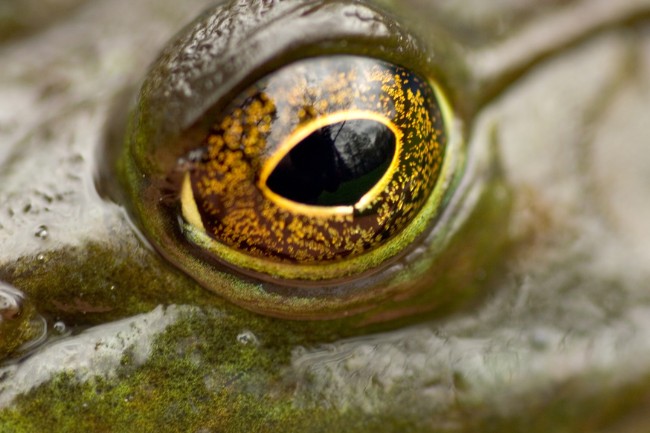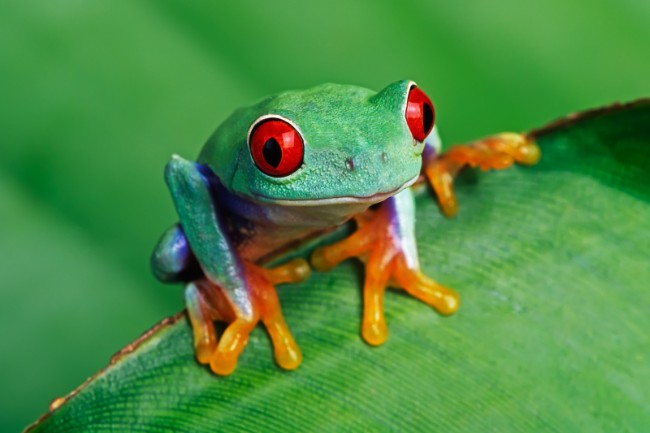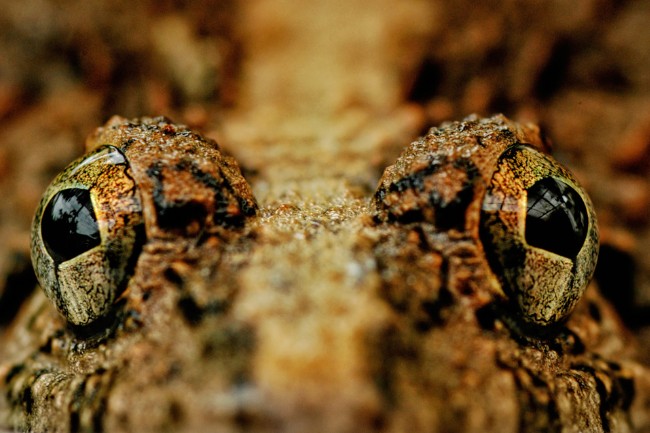Frogs are amphibians and are found across almost every continent in the world. They’re easily recognisable from their strong back legs, large mouths and in particular their large bulging eyes. Yet few people will have given much thought to how they blink. Many people may even assume that frogs don’t blink. However, blinking is vital for frogs in a surprising number of ways.
Without the ability to blink frogs would not be able to look after the complex type of eye they have evolved. In this articles we discuss how frogs eyes work, how they blink and why it’s so important for them.
Also read: Limb Regeneration: Can Frogs Regrow Their Legs?
The Anatomy of a Frog’s Eye
Frogs’ eyes are surprisingly similar to the human eye. They are a camera-type eye, with a structure which uses a lens to capture light. They have a large fluid-filled eyeball, at the back of which sits the optic nerve.
At the front of the eye is a lens, with muscle attachments which can help move it to focus the eye. Frogs are adapted to focus more on moving objects, to help them capture fast moving prey. They can have surprisingly diverse pupil shapes, including horizontal and vertical slits, and round pupils. Frogs can even have different coloured eyes, from black to green, even to red.
| Frog Species | Eye Anatomy and Adaptations | Additional Information |
|---|---|---|
| Pacman Frog | Large, bulging eyes with a protective nictitating membrane | Eyes are positioned on top of the head, providing a wide field of vision |
| Glass Frog | Transparent skin allows for visibility of internal eye structures | Eyes are positioned forward, aiding in binocular vision and depth perception |
| Tungara Frog | Males possess inflatable vocal sacs that cover their eyes during calls | Eye coloration and movements play a role in visual communication during courtship |
| Tree Frog | Possess a specialized retina for enhanced low-light vision | Vertical-slit pupils allow for better adaptation to low light conditions |
The position of the frogs eyes is particularly important, as being high on their head means they can see both in front, to the side, and slightly behind them. This is very useful for a creature that’s everyone’s favourite snack.

Another helpful adaptation is that frogs are able to see better in the dark than humans. For some species this is because they hunt at night, when more of their prey might be active. It also allows them to stay alert for predators.
A key difference between a frog’s eyes and human eyes is that frogs can only focus around 6 inches in front of them, this amazing short sightedness means much of the world is fuzzy for frogs.
The Purpose of Blinking
Blinking is the action of moving one or both eyelids over an eye. It’s a common way for animals to keep their eyes moist, protect them from harm and shut out light.
Not all animals have eyelids, with many insects instead manually cleaning their eyes with their arms. Mammals, reptiles and birds all have eyelids.
Do Frogs Blink?
Frogs do blink, using their eyelids to cover their eyes. In fact, you could say frogs blink more than humans, due to the fact they have three eyelids. As well as the upper and lower eyelids, frogs have a third eyelid, known as a nictitating membrane.
The nictitating membrane is semi-transparent lid, and helps to keep the eye moist by spreading oil from a specialist gland. Its transparency also has the benefit of allowing the frog to look out for predators. It’s common for frogs to rely on this eyelid when they’re underwater or hibernating.
| Frog Species | Blinking Behavior | Additional Information |
|---|---|---|
| American Bullfrog | Does not blink | Has a protective transparent eyelid called a nictitating membrane |
| Red-eyed Tree Frog | Does not blink | Keeps eyes open while resting, even during sleep |
| African Clawed Frog | Does not blink | Possesses a transparent nictitating membrane that protects the eyes |
| Green Tree Frog | Rarely blinks, may exhibit partial blinking | May exhibit partial blinking during certain behaviors or environmental cues |
Although this third eyelid is semi-transparent, using it does mean that frogs lose some of their vision. However, many frogs rely heavily on smell and vibrations as additional sense to keep them safe and fed, so block out a little vision isn’t the end of the world.

The red-eyed tree frog has a particularly striking nicitating membrane, with it having a pattern of veins across it, similar to those on a leaf. The reason for this it to help camouflage their particularly striking red eyes, which could attract the attention of larger animals.
Interestingly, frogs don’t so much cover their eye with their eyelids as push their eye down into the lids. As a frog’s eyes sit above its head it has muscles that pull the eye down into its skull. These same muscles cause the lower lid, to which the nictitating membrane is attached, to move across the eye. The upper lid has no muscular attachments, and simply moves with the eyeball.
It’s also worth noting that a frog’s eyes will change from its life as a tadpole to when it metamorphosises into an adult. This is in part because most tadpoles spend their days in the water, whereas adult frogs spend their time on the land. As light travels differently through water and air, slightly different eye anatomies are useful at their distinct stages.
The Function of Blinking in Frogs
There are a number of reasons why a frog may blink. As in all animals blinking occurs regularly even without cause, however they can make themselves blink more in certain circumstances. The main reasons are the same as the reasons why all animals blink.
Firstly, blinking is important for clearing the eye of dirt, in order to keep it healthy. Dirt can result in damaging the surface of the eye, which could affect how it functions. It can also clear parasites, fungal spores, and other potentially harmful substances.
Blinking is also important for protecting the eye from potential damage, during fights with rival frogs, attacks from predators, or when swallowing food.

Finally, the nictitating membrane helps to moisten the eye, preventing it from drying out. Frogs in general are at risk of dehydration, due to their thin skin, however it is particularly important for the eye to remain moist so that it can continue to function.
As well as all this, blinking has another important function for frogs. Frogs are well-known for their bulbous eyes. When it comes time to swallow their prey, frogs push their eyes down into their mouth in order to force the living animal down their throat. Quite an impressive blink.
Conclusion
So when it comes to a frog’s blink, there’s a surprising amount to it. Not only do they have an extra eyelid, which helps keep their eye moist while allowing them to stay alert, but they can use their blink to swallow their food.
Eyes are such an important tool for most animals, including frogs. They help them find their food, keep away from danger, and identify a mate. However, they are also not quite as good as human eyes, not being good at focusing on objects far away, or picking up on non-moving prey.
Still when you see a frog use it’s lightning strike tongue to grab a tiny fly, it’s hard not to be impressed at what they little creatures can see and do.

